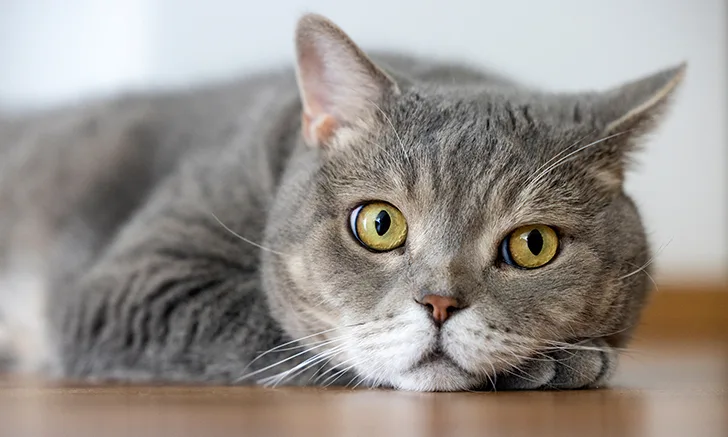Clinical Challenge: Finding Relief from Feline Osteoarthritis

Sponsored by Zoetis
Osteoarthritis (OA) is common in cats, affecting 60% of adult cats and 90% of cats >10 years of age.1 However, the signs of OA can easily be missed by veterinarians and pet owners alike, especially because overt lameness is rare.1,2 To further complicate matters, safe and effective treatments for OA are limited, particularly in older cats with concurrent conditions.
Feline Osteoarthritis: Abby’s Case
Abby, a 9.5-lb (4.3 kg), 13-year-old spayed, female domestic shorthair cat, was presented for behavioral changes. Her owner had noted she was sleeping more, was reluctant to jump onto the window ledge, and had been having urinary accidents.
Abby had not been seen by her veterinarian for several years. However, her veterinary clinic had recently set a goal to see more feline patients, so when Abby’s owner was in for a recent annual visit with her dog, she was asked how Abby was and encouraged to bring her in for an examination.
A demographic survey published in 2020 found that only 44% of cat owners bring their cat in for an annual preventive visit.3 Potential reasons for not regularly bringing cats to the clinic include difficulty getting the cat to the clinic, low awareness of basic feline medical needs, inability to recognize subtle signs of illness, a misconception that indoor-only cats are protected from illness, and the potentially lower perceived value of cats.4
Patient history was obtained by Abby’s veterinarian. Overall, she had been doing well, with a good appetite and no polyuria or polydipsia. There was 1 covered litter box in the basement, but Abby had been having sporadic urinary accidents on the first floor. No stranguria, pollakiuria, or hematuria were noted, and bowel movements appeared normal. Abby was not up to date on vaccinations and was not on parasite prevention. One small dog also lived in the home.
On physical examination, Abby was mildly anxious and was overweight, with a BCS of 7/9. Mucous membranes were pink and moist, with a capillary refill time of <2 seconds. She had mild dental gingivitis. Heart rate was 170 bpm, with no murmurs or arrhythmia noted. Respiratory rate was 28 breaths per minute, with normal lung sounds.
On gait examination, Abby was mildly short-strided in her pelvic limbs. She would not tolerate full hip extension bilaterally, and there was mild bilateral atrophy of her thigh musculature. No neurologic deficits were noted, and thoracic limbs were palpated normally. The remainder of Abby’s physical examination was within normal limits.
Preliminary Diagnostic Testing
Based on physical examination findings and Abby’s age, her veterinarian recommended a CBC, serum chemistry profile, and urinalysis. No abnormalities were detected.
Sedated radiography of the hips, stifle, and caudal spine revealed moderate OA in both hips, with osteophyte formation at the dorsocranial acetabular rims.
OA is less well understood in cats as compared with dogs. Although the primary cause of OA often cannot be identified, most cases are primary or idiopathic.5 Secondary OA can occur in some cases and often occurs secondary to trauma or inherited conditions such as hip dysplasia or acromegaly.1,5
Feline Osteoarthritis
A cross-sectional study found that OA was most prevalent in the shoulders, elbows, hips, and tarsal joint; 61% of cats ≥6 years of age had OA in at least 1 joint, and 48% had OA in >1 joint.6
Although the radiographic prevalence of feline OA is high and increases rapidly with age, pain detection is not necessarily related to radiographic evidence of OA.2,7 In one study, no evidence of OA was noted in 15% of apparently painful joints,8 and in another, only 33% of joints with radiographic signs of OA were painful.9
Although the radiographic prevalence of feline OA is high and increases rapidly with age, pain detection is not necessarily related to radiographic evidence of OA.
Behavioral changes are key to diagnosing OA in cats.1,2 Possible changes include house-soiling, altered social interactions, vocalization, objection to handling, and changes in play, hunting behavior, posture, activity level, grooming behavior, and mobility (eg, jumping, stairs).2 The owners of cats at risk must be questioned carefully about subtle behavioral changes.
Treatment Options for Abby
Treatments for OA in cats include meloxicam, robenacoxib, gabapentin, amantadine, tramadol, and buprenorphine.1,10 However, no NSAIDs are currently licensed for long-term use to treat OA pain in cats in the United States, and a high proportion of cats with OA have concurrent renal disease, which impacts the safety of long-term NSAID use.1,10 Most feline analgesics have to be administered orally, which also can be challenging for many owners.
Considering these factors, Abby’s veterinarian recommended Solensia (frunevetmab injection), a felinized monoclonal antibody.
Solensia binds to nerve growth factor (NGF), which plays an important role in nociceptor sensitization in a variety of acute and chronic pain states, including OA pain.11 NGF is produced and released in peripheral tissue in response to noxious stimuli and transported to sensory neurons, where it causes increased sensitivity to pronociceptive neurotransmitters and stimulates the release of proinflammatory mediators (eg, histamine, serotonin, NGF).10 NGF is released by damaged cells in arthritic joints, playing an important role in the pain associated with OA.11,12
Abby was given a subcutaneous injection at a dose of 1.5 mg/kg (1 mL of 7 mg/mL solution) and tolerated it well. Abby’s veterinarian also discussed weight loss and environmental management for OA, including moving the litter box upstairs, finding a litter box with a lower ledge, and using stairs/ramps to help her get up on furniture.
NGF is released by damaged cells in arthritic joints, playing an important role in the pain associated with OA.
A follow-up phone call was made 2 weeks later, and Abby was doing well. Abby was more playful and was soliciting affection again, and no further urinary accidents had occurred. No adverse effects were noted by the owner.
Solensia
Studies have shown that Solensia has statistically significant efficacy as compared with placebo in the control of pain associated with OA in cats.10,11 Results included decreased mobility impairment, disability, and pain.10,11
Using Solensia avoids the need for oral pain medication and provides long-lasting effectiveness.10 It is generally well-tolerated in cats. In a study, most adverse effects occurred with similar frequency in both the placebo and treatment groups. Skin-related adverse events, however, did have increased frequency in the treatment group.11 If skin reactions occur, they typically involve scabbing on the head and neck, dermatitis, and pruritus; they are also often mild, often do not require treatment, and do not require discontinuation of Solensia.11
In pharmacokinetic studies, peak drug levels of Solensia were found between 3 and 7 days following SC injection, and steady state levels were obtained after 2 monthly doses.13 Solensia is dosed based on body weight to target a minimum dosage of 0.45 mg/lb (1 mg/kg), administered SC once a month.13
What Can We Learn from Abby’s Case?
Behavioral signs are crucial in the diagnosis of OA, and the importance of asking cat owners about behavioral changes cannot be overstated. Many cat owners may think the signs of OA are just due to “normal aging” and may not recognize their significance.
Administering oral medications to cats can be stressful and can harm the animal–human bond. Solensia provides safe, effective, long-lasting control of pain associated with OA and avoids the need for oral pain medication.
IMPORTANT SAFETY INFORMATION
For use in cats only. Women who are pregnant, trying to conceive or breastfeeding should take extreme care to avoid self-injection. Hypersensitivity reactions, including anaphylaxis, could potentially occur with self-injection. Solensia should not be used in breeding cats or in pregnant or lactating queens. Solensia should not be administered to cats with known hypersensitivity to frunevetmab. The most common adverse events reported in a clinical study were vomiting and injection site pain. See full Prescribing Information at www.SolensiaPI.com.
All trademarks are the property of Zoetis Services LLC or a related company or a licensor unless otherwise noted. SLN-00263
